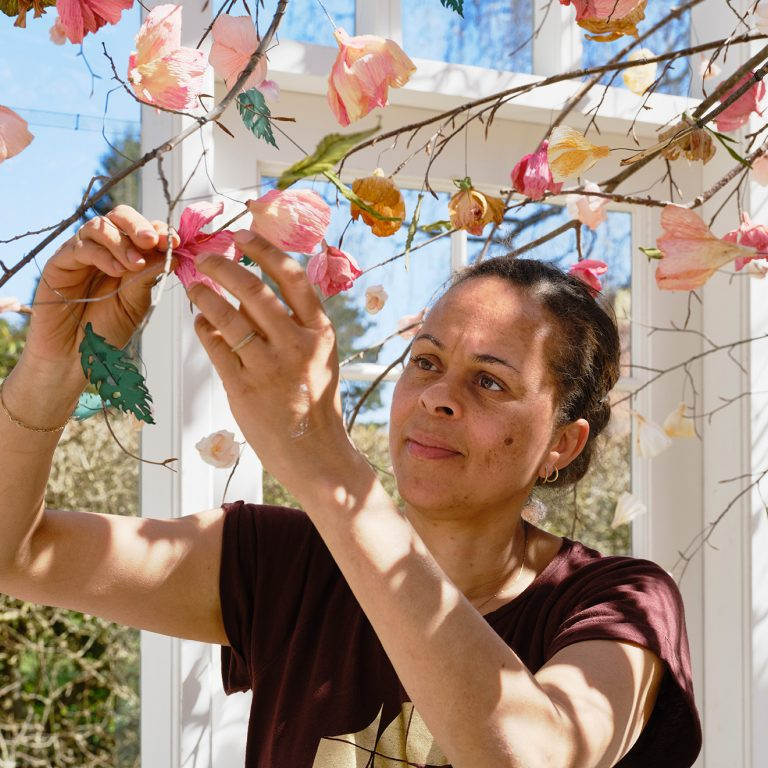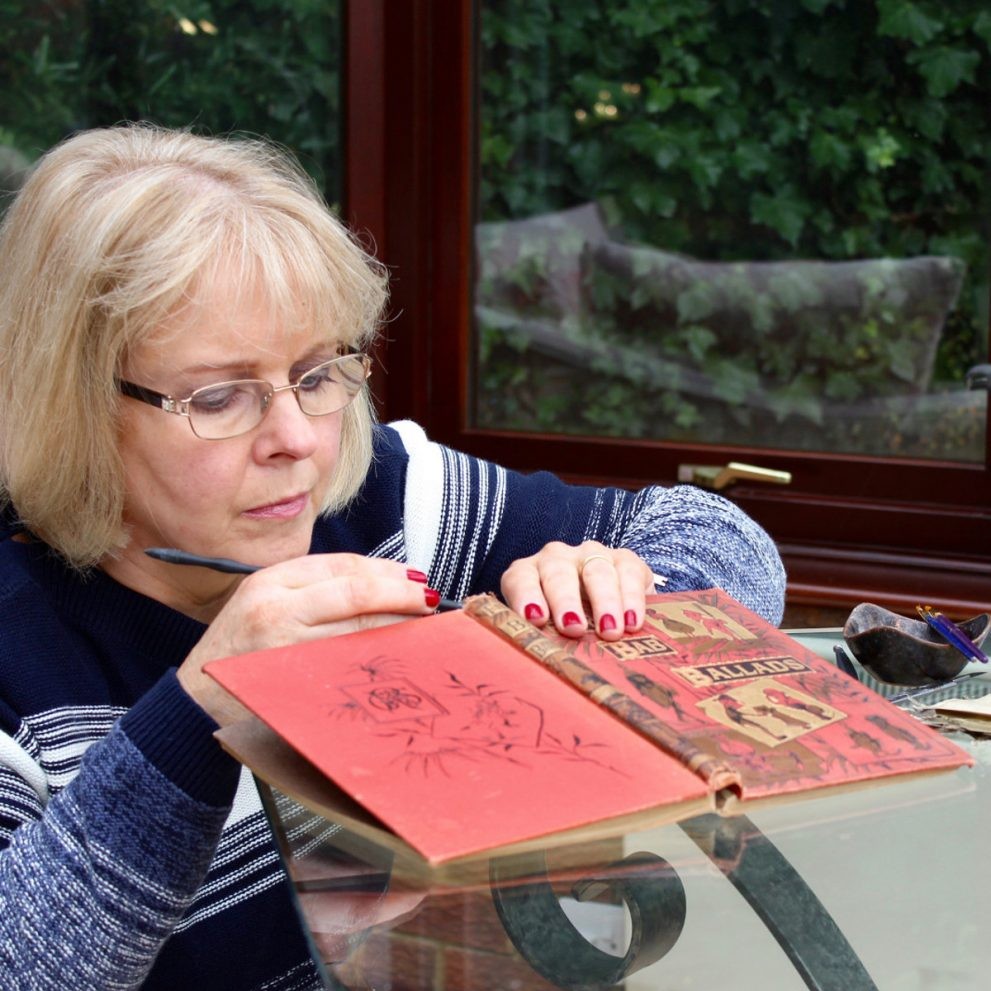Mandy Gunn Eco Artist, Printmaker - Victoria, Australia
When did you leave conventional textiles and start work with recycled medium?
I started weaving in about 1971 initially using giant heavy hand spun and dyed wool to make large sculptural works but even back then I made pieces from recycled film tape and raw materials like sisal so I think there was always that interest in the different natures of found material, their textures and the way they can tell stories. I definitely was never interested in weaving fabric! From loom made pieces I have progressed over the years to include many hand cut assemblage works which are really based on the woven grid form.
Tell us about being chosen for the 2010 Tapestry Triennale in Poland and the work you sent?
Three artists from Australia were recommended by Valerie Kirk Head of Textiles at ANU and we all received official invitations from the Triennale Committee.
The work I sent was made from hand shredded and woven Melbourne Yellow Pages and hung from the ceiling in a cascading waterfall shape over suspended Perspex rods and then came to rest on the floor.
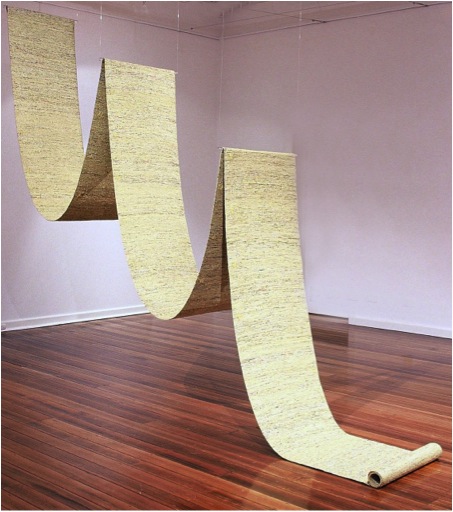
Scroll
It was 10 metres in length and 60 cm wide. Snippets of text and colour appeared through the weaving which was like a durable fabric tightly beaten down on the loom and with the overall look – as one viewer put it- of yellow slub silk. The material was such a familiar one but people were intrigued and fascinated by its nature and only had inkling of what it was when they examined it really closely! I really like it when a work can be viewed one way from a distance and quite differently at close quarters.
I called the work “Scroll” in reference to the ancient way of transmitting information but also because the work’s surface is similar to the pixilation’s of a computer screen. I also had woven – in yellow cotton – small triangles similar to the computer screen scroll sign-at intervals the whole length of the fabric.
The beauty of working with such ordinary everyday materials is that they comes in unlimited quantities so you can experiment quite a lot and make a few pieces from them.
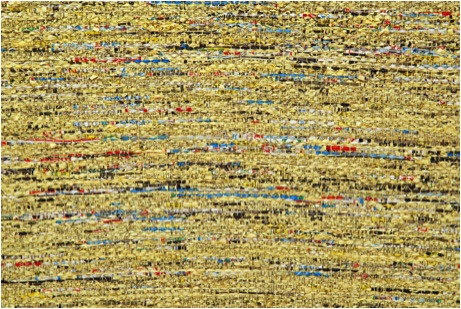
This work started me on an ongoing investigation between TEXT and TEXTILES. Text is usually explicit and obvious; textiles are understood in a more cultural, unstated way. By making Text into a Textile where only minute pieces of text render any meaning unmeaningful the boundaries between the two become blurred and the viewer has to look at the work differently.
Because I am fascinated with the use of recycled materials in your art I would like to ask the questions slightly differently. I will ask about different materials and if you could explain your use of them in your art.
Met Cards – these are public transport cards

Yes Metcards – which will be replaced by the automated Myki system – are Melbourne’s public transport tickets. Over the years many of them were designed and produced to advertise Melbourne venues and events such as the Flower Show, the Art Fair, the Olympic Soccer, Luna Park so they are an archive of what has gone on in the city over a number of years. At one time, for quite a few years, I travelled on the train into Melbourne every day and I started a ticket collection but it took me quite a while to come up with an idea for how to use them. Eventually I started to collage them on to recycled cardboard and then cut them into strips and reconstruct them into 3 dimensional grid like forms making reference to the construction system of weaving as well as transport grids and lines. By the time I really got into this work, while I was doing a Masters degree at the Victorian College of the Arts, people were also saving tickets for me and even sending them in the post! I made a huge number of these pieces which have been shown all over Australia as well as the Philippines and are in quite a few public gallery collections.
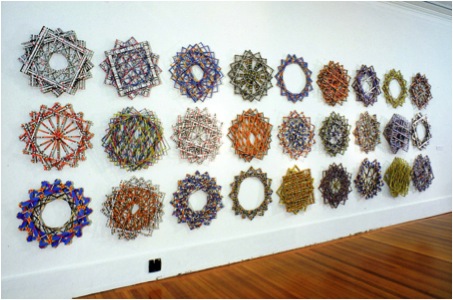
City Circle

Inner Circle #2
Oxford Dictionary
After I had woven Scroll, I looked around and found I had an old Oxford Dictionary as well as various inherited Bibles and prayer books which I thought I would I would try cutting and weaving. All these type of books are made from thin strong tissue like paper which stands up to shredding and manipulation and compression during the weaving process. This launched me into a big series of woven books, including various classics. The work is sculptural and can be arranged in a few different ways as well as being a textile, an artist’s book and a work with paper so I have been able to exhibit in many different types of exhibitions and somewhat to my initial surprise the woven books have ended up in a lot of public and private collections
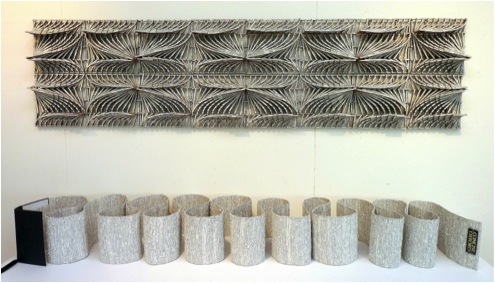
The Unconcise Oxford Dictionary
Various books, magazines and paper
I love working with cast off paper-it comes in so many guises, is readily available and is easy in a hands on way to work with. My best loved studio tools would have to be cutting mats, steel rulers and snap off blade knives plus of course weaving looms. I think I would have cut kilometres of various papers collaged on to cardboard and woven a similar amount of cut up strips of paper!

Detail of Woven Book Pages
All this work of course makes reference to the terrible amount of waste produced by our society as well as the importance we place on printed matter.

The grid like forms initially used in the Metcard series have become much more experimental and reinvented themselves into all manner of curves and sculptural shapes. In the past 2 years I have been combining the small cut paper grids together into larger repetitive shapes and installing these as a wall component with the woven book forms. “Patterns of Speech, the Complete Works of Shakespeare’, a large installation piece recently shown in the National Works on Paper at the Mornington Peninsula Gallery in Victoria is one of a number of these works. “Between the Lines” is another large series of smaller individual works shown installation style which uses collaged grid forms from disparate printed waste.
Inner tubes
I began collecting inner tubes while travelling on camping trips around the outback as the roads are littered with burnt out specimens and I thought I would be able to cut them up by hand with scissors while sitting in the car-a sort of transportable studio workplace.
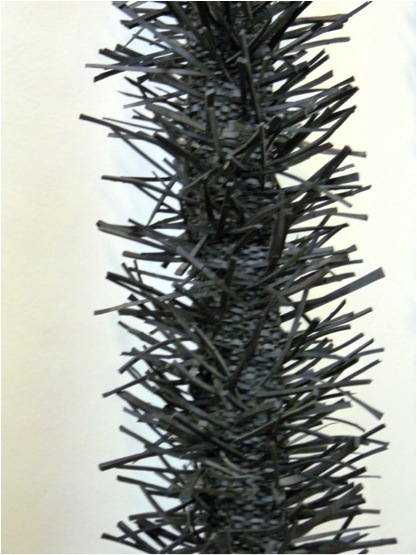
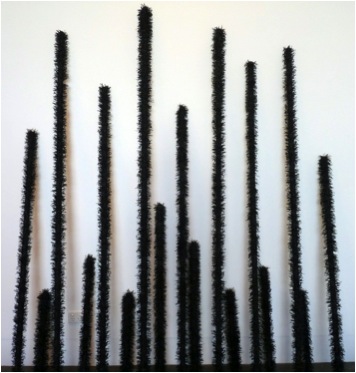
This began a series of woven works in which short thin pieces of tube were overlapped, with the ends of each left hanging out to create a spiky effect.
The time of making these coincided with the recent terrible Victorian bushfires and I began to see the work was similar in form and appearance to the burnt out blackened bush.
The Firesticks series, consisting of thin long strips of woven spiky material sewn around wood batons to make them rigid, lean up against the wall and make reference to the burnt out landscape as well as the traditional indigenous practice of Firestick Farming where areas are periodically burnt off to encourage new growth and prevent wildfires. This practice has now been taken up in areas such as the Kimberleys where aerial firebombs are seasonally dropped into remote country to burn off thick vegetation.
Natural and man-made objects? (emu eggs, pine needles and tacks)
Over the past 15 years I have worked quite a bit on environmental sculpture installations. I spent a month one year at Bundanon, Arthur Boyd’s property on the Shoalhaven, in NSW, working exclusively with naturally occurring materials-sticks, rocks, seed pods, berries, plant material etc. This was mostly ephemeral work and left to disintegrate back into the landscape in time.
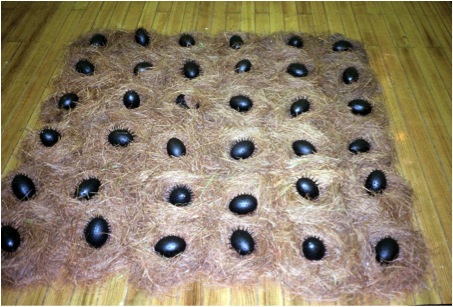
I have also collected various objects such as emu eggs to which I applied carpet tacks to create an all over ‘Unnatural History” look- a reference to the Victorian practice of collecting emu eggs as curios which were then carved and mounted in silver settings as examples of weird colonial fauna. Like the Yellow Pages, viewers aren’t quite sure what the prickly looking objects are, even though they look vaguely familiar.

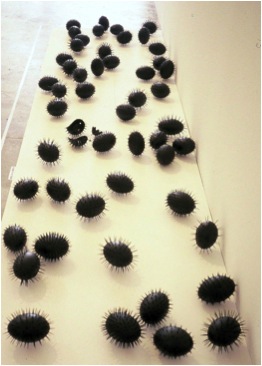
I have shown these pieces singly, mounted in Perspex boxes as well as en masse in nests of pine needles-and of course pine trees are not native to Australia so are also Unnatural History.
Other collections include dead road kill echidna from which I have extracted the spines to weave into necklace like lengths; hundreds of bracken sticks woven into 10 metre lengths and then twisted into spirals to install on the edge of Lake Cootharaba as part of the Floating Land event at Noosa, Queensland, in 2009.
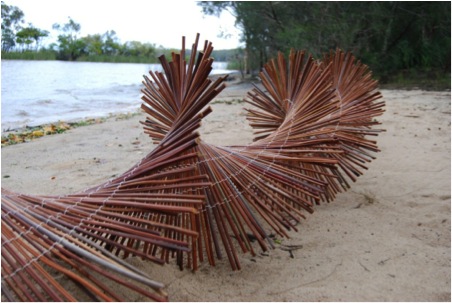
Rusted strapping from old mine shafts around Broken Hill, NSW which I cut, wove by hand and riveted then twisted into wave like lengths and also rusted fence droppers from farm tips built up into balanced constructed edifices.
I have always been a collector and hoarder and enjoy the challenge of re using materials to create something new which has its own inbuilt history and references from past uses.
The process of making is initially very experimental to find out what you can do with these different things, so I am quite open minded and don’t come at the work with preconceived notions until I hit on some process which works and seems meaningful to me.
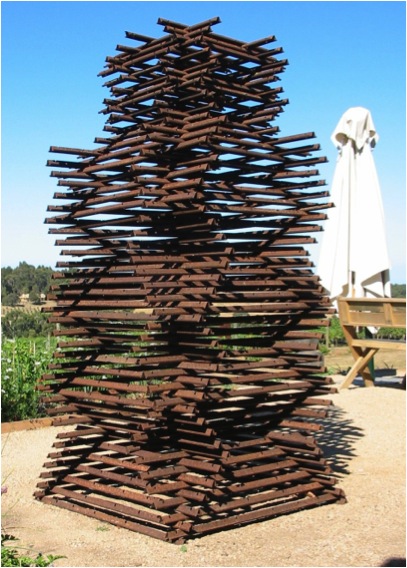
Fence/Defence, stacked steel fence droppers
Can you tell us what you are currently working on?
Twelve years ago I saved a couple of beautiful printed paper shopping bags to do something with and lately I have added considerably to these with the help of friends’ donations. Again they have been collaged onto cardboard and cut into a large grid installation series which I plan to show at a residency I am doing at the Art Vault in Mildura in February, 2013. As more bags keep arriving I have the feeling that this series will keep growing!.
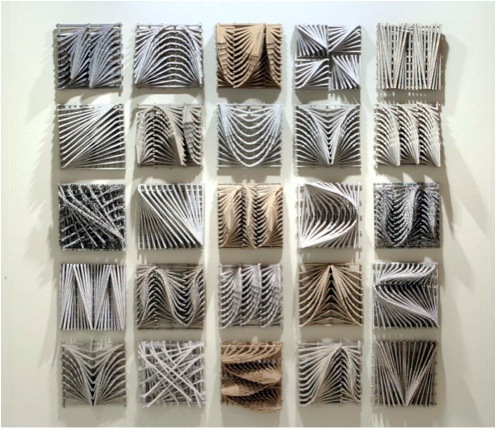
Cut between the lines
Contact Details
www.mandygunnart.com
Mobile: 0411257045
Mandy Gunn, Victoria, Australia
Interview by Deborah Blakeley, February 2013
Think a colleague or friend could benefit from this interview?
Knowledge is one of the biggest assets in any business. So why not forward this on to your friends and colleagues so they too can start taking advantage of the insightful information the artist has given?
Other artists you may be interested in:




